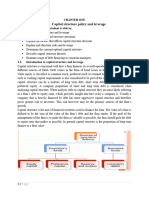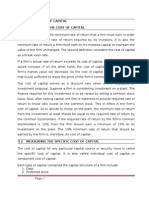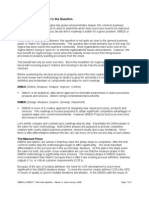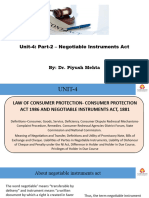0 ratings0% found this document useful (0 votes)
298 viewsChapter-9, Capital Structure
This document provides an overview of capital structure including definitions, components, forms, importance, theories, and examples. It defines capital structure as the composition of a company's long-term capital, including debt, preference shares, and equity shares. It discusses theories of capital structure such as the net income approach, net operating income approach, traditional approach, and Modigliani-Miller approach. Practical problems demonstrate calculating EPS and firm value under different capital structures.
Uploaded by
Pooja SheoranCopyright
© © All Rights Reserved
Available Formats
Download as PPTX, PDF, TXT or read online on Scribd
0 ratings0% found this document useful (0 votes)
298 viewsChapter-9, Capital Structure
This document provides an overview of capital structure including definitions, components, forms, importance, theories, and examples. It defines capital structure as the composition of a company's long-term capital, including debt, preference shares, and equity shares. It discusses theories of capital structure such as the net income approach, net operating income approach, traditional approach, and Modigliani-Miller approach. Practical problems demonstrate calculating EPS and firm value under different capital structures.
Uploaded by
Pooja SheoranCopyright
© © All Rights Reserved
Available Formats
Download as PPTX, PDF, TXT or read online on Scribd
You are on page 1/ 21
Chapter
Capital Structure &
theories of Capital
Structure
Meaning & Definition
Capital Structure of a company refers to the composition or make- up of its capitalisation & it
includes all long term capital resources viz: loans, Reserves, Shares & bonds.
Capital Structure is made up of debt & equity securities & refers to permanent financing of a firm.
It is composed of long-term debt, preference share capital & shareholders funds.
Capitalisation, Capital Structure & Financial
Structure
Capitalisation is quantitative aspect of financial planning of an enterprise, capital structure is
concerned with the qualitative aspect. Thus Capitalisation refers to the total amount of
securities issued by a company while capital structure refers to the kind of securities & the
proportionate amounts that make up capitalisation.
Financial Structure means the entire liabilties side of Balance Sheet.
Forms/Patterns of Capital Structure
Equity
Shares
Only
Equity &
preference
Shares
Equity
Shares &
Debentures
Equity
Shares,
Preference
Shares &
Debentures
Importance Of Capital Structure
Financing the firms assets is a very crucial problem in every business & as a
general rule there should be a proper mix of debt & equity capital in financing
firms assets. The use of long term fixed interest bearing debt & preference share
capital along with equity shares is called financial leverage or trading on equity.
Practical Problem 1
XYZ company has currently an all equity capital structure consisting of
15,000 equity shares of Rs. 100 each. The management is planning to raise
further Rs. 25 laks to finance a major programme of expansion & is
considering three alternative methods of financing:
To issue 25,000 equity shares of Rs. 100 each
To issue 25,000, 8% debentures of Rs. 100 each
To issue 25,000, 8% preference shares of Rs. 100 each
The company expected earnings before interest & taxes will be Rs. 8 laks.
Assuming a corporate tax rate of 50% determine EPS in each alternative &
comment which alternative is best & why?
Practical Problem 2
X Ltd. Company has equity share capital of Rs. 5,00 000 divided into shares of Rs.
100 each. It wishes to raise further Rs. 3,00,000 for expansion. The company plans
the following schemes:
All Common stock
Rs. One lak in common stock & Rs. Two Lak in debt @10% p.a.
All debt @10%p.a.
Rs. One lak in common stock & Rs. Two lak in preference capital with the rate of
dividend @ 8%.
The company existing earning before interest & tax Rs. 1,50,000.The corporate rate
of tax is 50%. Determine the EPS in each plan & comment.
Optimal capital Structure
The Capital Structure or combination of debt & equity that leads to the maximum
value of the firm, is known as optimal capital structure. Thus Optimal capital
structure maximises the value of the company & hence the wealth of its owners &
minimises the company cost of capital. The following consideration should be kept
in mind while maximising the value of the firm in achieving the goal of optimum
capital structure:
If the return on investment is higher than the fixed cost of funds, the company
should prefer to raise fund having fixed cost, it will increaser EPS & market value of
the firm.
Company must take the advantage of tax leverage as interest is allowed as a
deductible expense in computation of tax.
Capital structure should be flexible
DETERMINANTS OF OCS
A SOUND OR AN APPROPRIATE CAPITAL STRUCTURE SHOULD HAVE THE FOLLOWING
ESSENTIAL FEATURES:
Maximum possible use of leverage
Capital Structure should be flexible
Avoidance of undue financial/business risk with the increase use of debt
Use of debt should be within the capacity of a firm.
It should involve minimum possible risk of loss of control
It must avoid undue restrictions in agreement of debt
Growth & stability of sales
Cost of capital
Nature & size of a firm
Capital market conditions
Period of finance
Personal considerations
Corporate tax rate & legal requirement
Theories of CS
Net Income
Approach
Net
Operating
Income
Approach
The
Traditional
Approach
Modigliani &
Miller
Approach
Net Income Approach
As per this approach, a firm can minimize the weighted average cost of capital
&increase the value of the firm as well as market price of equity shares by using
debt financing to the maximum possible extent. This approach is based upon the
following assumptions:
Cost of debt is less than the cost of equity
No taxes
1. No change in risk perception of the investors.
2. The total market value of the firm on the basis of this approach is:
3. V=S+D Where V=Total market value of a firm
1. S=Market value of equity share (Earnings available to
equity share holders/Equity Capitalisation rate)
2. D=Market value of debt
& Over all cost of capital is = K=EBIT/V
Practical problem
A company expects a net income of Rs. 80,000. It has Rs.
2,00,000, 8% debentures. The equity capitalisation rate of the
company is 10%. Calculate the value of the firm & over all cost
of capital as net income approach
If the debenture debt is increased to Rs. 3,00,000, what shall
be the value of the firm & over all capitalisation rate?
Net Operating Income approach
This theory as suggested by Durand is another extreme of the effect of the
leverage on the value of the firm. It is diametrically opposite to the net income
approach. As per this, change in the capital structure of a company doesnt affect
the market value of the firm & over all cost of capital remains constant irrespective
of the method of financing. It implies that over all cost of capital remains the
same, thus there Is nothing like optimal capital structure & every capital structure
is the optimum capital structure. This theory presumes:
Market capitalises the value of the firm as a whole
Business risk remains constant at every level of debt equity mix
No taxes
Cont..
The value of the firm on the basis of Net Operating Income Approach:
V=EBIT/K
Where V=Value of a firm
EBIT=Earnings before interest & tax
K=Over all cost of capital
The market value of equity as per this approach is the residual value which is
determined by deducting the market value of debentures from the market value of
the firm.
S=V-D
Practical Problem
A company expects a net operating income of Rs. 1,00,000. It has Rs.5,00,000, 6%
debentures. The over all capitalisation rate is 10%. Calculate the value of the firm
& the equity capitalisation rate according to net operating income approach.
If the debenture debt is increased to Rs. 7,50,000. what will be the effect on the
value of the firm & equity capitalisation rate.
Traditional Approach
The traditional approach also known as intermediate approach, is a compromise between the
two extremes of earlier two approaches. According to this theory, the value of the firm can
be increased initially or the cost of the capital can be decreased by using more debt as the
debt is a cheaper source of funds than equity. Thus, optimum capital structure can be
reached by a proper debt-equity mix. Beyond a particular point, the cost of equity increases
because increased debt increases the financial risk of the equity shareholders. The advantage
of cheaper debt at this point of capital structure is offset by increased cost of equity. After
this there comes a stage when the increased cost of equity cannot be off set by the
advantage of low-cost debt. Thus, over all cost of capital according to this theory decreases
up to a certain point, remains more or less unchanged for moderate increase in debt
thereafter & increases or rises beyond a certain point. Even the cost of debt may increase at
this stage due to increased financial risk.
Practical problem
Compute the market value of the firm, value of shares & the average cost of
capital from the following information:
Net Operating Income Rs. 2,00,000
Total Investment Rs. 10,00,000
Equity capitalisation rate
If the firm uses no debt 10%
If the firm uses Rs. 4,00,000 Debenture 11%
If the firm uses Rs. 6,00,000 debentures 13%
Assume that Rs. 4,00,000 debentures can be raised @ 5% of interest where as Rs.
6,00,000 debentures can be raised @6% rate of interest.
MODIGLIANI & MILLER APPROACH
In the absence of taxes (Theory of irrelevance): The theory proves that the cost of capital is
not affected by changes in the capital structure or that the debt-equity mix is irrelevant in the
determination of the total value of a firm. The reason argued is that though debt is cheaper
to equity, with increased use of debt as a source of finance, the cost of equity increases. This
increase in cost of equity offsets the advantage of the low cost of debt. Thus, although the
financial leverage affects the cost of equity, the over all cost of capital remains constant.
When corporate taxes are assumed to exist. (Theory of relevance): Modigliani & Miller, have
recognised that the value of a firm will increase or the cost of capital will decrease with the
use of debt on account of deductibility of interest charges for tax purposes. Thus the
optimum capital structure can be achieved by maximising the debt mix in the equity of a
firm.
According to this approach, the value of a unlevered & levered firm can be calculated as:
Vu = Earnings before interest & tax/overall cost of capital
Vl = Vu + tD
Where Vu is the value of unlevered firm & tD is the discounted present value of the tax
savings resulting from the tax deductibility of the interest charges, t is the rate of tax & D is
the quantum of debt used in the mix.
LEVERAGE
Leverage allows us to accomplish certain things which are otherwise not possible, viz; lifting
of heavy objects with the help of leverage. This concept of leverage is valid in business also.
In financial management, the term leverage is used to describe the firms ability to use fixed
cost assets or funds to increase the returns to its owners i.e. equity share holders.
There are basically two types of leverages:
Financial leverage or trading on equity
Operating Leverage
OPERATING LEVERAGE
Operating leverage results from the presence of fixed cost that help in magnifying net
operating income fluctuations flowing from small variations in revenue. The change in sales
are related to change in revenue. The fixed cost do not change with the change in sales. Any
increase in sales, fixed cost remaining the same, will magnify the operating revenue. The
operating leverage occurs when a firm has fixed costs, which must be recovered irrespective
of sales volume. The fixed cost remaining the same, the percentage change in operating
revenue will be more than the percentage change in sales. The occurrence is known as
operating leverage. Thus, the degree of operating leverage depends upon the amount of
fixed elements in the cost structure.
Operating Leverage = Contribution/Operating profit
Contribution = Sales Variable Cost
Operating profit = Sales Variable cost Fixed cost
Practical problem & solution
Following is the cost information of a firm:
Fixed Cost = Rs. 50,000 ; Variable Cost = 70% of sales; Sales = Rs.2,00,000 in previous year &
Rs. 2,50,000 in current year.
Solution:
1) PY CY %age change
Sales 2,00,000 2,50,000 25
Less: Variable cost(70%) 1,40,000 1,75,000 25
Profit from operations 60,000 75,000 25
2)
Sales 2,00,000 2,50,000 25
Less: Variable Cost(70%) 1,40,000 1,75,000 25
Contribution 60,000 75,000 25
Less: FC 50,000 50,000
Profit from operations 10,000 25,000 150
You might also like
- Bank Valuation and Value Based Management: Deposit and Loan Pricing, Performance Evaluation, and Risk, 2nd EditionFrom EverandBank Valuation and Value Based Management: Deposit and Loan Pricing, Performance Evaluation, and Risk, 2nd Edition1/5 (1)
- Exercices + Answers (Capital Structure) PDFNo ratings yetExercices + Answers (Capital Structure) PDF4 pages
- Cost of Capital Lecture Slides in PDF FormatNo ratings yetCost of Capital Lecture Slides in PDF Format18 pages
- Advance Accounting: Principles and Procedural ApplicationsNo ratings yetAdvance Accounting: Principles and Procedural Applications18 pages
- Capital Structure Theory - Net Operating Income Approach50% (2)Capital Structure Theory - Net Operating Income Approach3 pages
- Assignment 5 - CH 10 - The Cost of Capital PDF0% (1)Assignment 5 - CH 10 - The Cost of Capital PDF6 pages
- Solutions For Capital Budgeting QuestionsNo ratings yetSolutions For Capital Budgeting Questions7 pages
- Chapter 17 - Consolidated Financial Statements: Intragroup TransactionsNo ratings yetChapter 17 - Consolidated Financial Statements: Intragroup Transactions14 pages
- Capital Structure Theory - Net Operating Income ApproachNo ratings yetCapital Structure Theory - Net Operating Income Approach6 pages
- Corp Finance Group One Course Work (Final)No ratings yetCorp Finance Group One Course Work (Final)27 pages
- Unit Six: 6. Incremental Analysis: Decisions Making and Relevant Information0% (1)Unit Six: 6. Incremental Analysis: Decisions Making and Relevant Information58 pages
- Hand Notes On Cost of Capital and Capital Structure: Composed By: H. B. HamadNo ratings yetHand Notes On Cost of Capital and Capital Structure: Composed By: H. B. Hamad55 pages
- Capital Budgeting and Real Options EditedNo ratings yetCapital Budgeting and Real Options Edited29 pages
- Evaluating Project Economics and Capital Rationing: Before You Go On Questions and AnswersNo ratings yetEvaluating Project Economics and Capital Rationing: Before You Go On Questions and Answers46 pages
- Financial Leverage and Capital Structure PolicyNo ratings yetFinancial Leverage and Capital Structure Policy21 pages
- The Cost of Capital: All Rights ReservedNo ratings yetThe Cost of Capital: All Rights Reserved56 pages
- Q1) What Is Cost of Capital? How Is It Calculated For Different Sources of Capital? How Is Average Weighted Cost of Capital Measured?No ratings yetQ1) What Is Cost of Capital? How Is It Calculated For Different Sources of Capital? How Is Average Weighted Cost of Capital Measured?18 pages
- Blocks To Creativity & Conducing Factors To CreativityNo ratings yetBlocks To Creativity & Conducing Factors To Creativity17 pages
- Suspended Judgement and Six Thinking HatsNo ratings yetSuspended Judgement and Six Thinking Hats43 pages
- Dynamics That Underlie Creative ThinkingNo ratings yetDynamics That Underlie Creative Thinking20 pages
- Suspended Judgement and Six Thinking HatsNo ratings yetSuspended Judgement and Six Thinking Hats43 pages
- Consumption Function: "Consumption Is The Sole End and Purpose of All Production." Adam SmithNo ratings yetConsumption Function: "Consumption Is The Sole End and Purpose of All Production." Adam Smith28 pages
- Mission Statement vs. Vision Statement: Compare AnythingNo ratings yetMission Statement vs. Vision Statement: Compare Anything6 pages
- Theory of Consumer Behavior - Indifference CurveNo ratings yetTheory of Consumer Behavior - Indifference Curve64 pages
- Corporate Governance Best Practices: ( Exception - Private Company)No ratings yetCorporate Governance Best Practices: ( Exception - Private Company)3 pages
- Entrepreneurship & Small Business: Chapter 4: Discovering A Business IdeaNo ratings yetEntrepreneurship & Small Business: Chapter 4: Discovering A Business Idea42 pages
- Presented By: Pooja Chaudhary, Ripunjaya K Chauhan: MOOCS at Edinburgh - Google HE Summit, London - 200912 1No ratings yetPresented By: Pooja Chaudhary, Ripunjaya K Chauhan: MOOCS at Edinburgh - Google HE Summit, London - 200912 139 pages
- Its Impact On India: Sunil Kumar AgrawalNo ratings yetIts Impact On India: Sunil Kumar Agrawal12 pages
- An Introduction To Integrated Marketing CommunicationNo ratings yetAn Introduction To Integrated Marketing Communication57 pages
- Dmedi or Dmaic That Is The Question 1137No ratings yetDmedi or Dmaic That Is The Question 11374 pages
- SEC511 & OPN272 Financial and Investment SkillsNo ratings yetSEC511 & OPN272 Financial and Investment Skills264 pages
- For Individuals Filing Via The Online Application: Nursing Jurisprudence Examination (Nje)No ratings yetFor Individuals Filing Via The Online Application: Nursing Jurisprudence Examination (Nje)10 pages
- Regulatory Compliance India Covid 19 PDFNo ratings yetRegulatory Compliance India Covid 19 PDF12 pages
- Final Report On MEL by MR - Gurpreet Singh ChahalNo ratings yetFinal Report On MEL by MR - Gurpreet Singh Chahal65 pages
- SAP Upgrade Services-Terrenos Software Technologies PVT LTDNo ratings yetSAP Upgrade Services-Terrenos Software Technologies PVT LTD3 pages
- The Answer of Case Sullivan Ford Auto WoNo ratings yetThe Answer of Case Sullivan Ford Auto Wo14 pages
- Bank Valuation and Value Based Management: Deposit and Loan Pricing, Performance Evaluation, and Risk, 2nd EditionFrom EverandBank Valuation and Value Based Management: Deposit and Loan Pricing, Performance Evaluation, and Risk, 2nd Edition
- Advance Accounting: Principles and Procedural ApplicationsAdvance Accounting: Principles and Procedural Applications
- Capital Structure Theory - Net Operating Income ApproachCapital Structure Theory - Net Operating Income Approach
- Chapter 17 - Consolidated Financial Statements: Intragroup TransactionsChapter 17 - Consolidated Financial Statements: Intragroup Transactions
- Capital Structure Theory - Net Operating Income ApproachCapital Structure Theory - Net Operating Income Approach
- Unit Six: 6. Incremental Analysis: Decisions Making and Relevant InformationUnit Six: 6. Incremental Analysis: Decisions Making and Relevant Information
- Hand Notes On Cost of Capital and Capital Structure: Composed By: H. B. HamadHand Notes On Cost of Capital and Capital Structure: Composed By: H. B. Hamad
- Evaluating Project Economics and Capital Rationing: Before You Go On Questions and AnswersEvaluating Project Economics and Capital Rationing: Before You Go On Questions and Answers
- Q1) What Is Cost of Capital? How Is It Calculated For Different Sources of Capital? How Is Average Weighted Cost of Capital Measured?Q1) What Is Cost of Capital? How Is It Calculated For Different Sources of Capital? How Is Average Weighted Cost of Capital Measured?
- Portfolio Performance Measurement and BenchmarkingFrom EverandPortfolio Performance Measurement and Benchmarking
- Capital expenditure Complete Self-Assessment GuideFrom EverandCapital expenditure Complete Self-Assessment Guide
- Blocks To Creativity & Conducing Factors To CreativityBlocks To Creativity & Conducing Factors To Creativity
- Consumption Function: "Consumption Is The Sole End and Purpose of All Production." Adam SmithConsumption Function: "Consumption Is The Sole End and Purpose of All Production." Adam Smith
- Mission Statement vs. Vision Statement: Compare AnythingMission Statement vs. Vision Statement: Compare Anything
- Corporate Governance Best Practices: ( Exception - Private Company)Corporate Governance Best Practices: ( Exception - Private Company)
- Entrepreneurship & Small Business: Chapter 4: Discovering A Business IdeaEntrepreneurship & Small Business: Chapter 4: Discovering A Business Idea
- Presented By: Pooja Chaudhary, Ripunjaya K Chauhan: MOOCS at Edinburgh - Google HE Summit, London - 200912 1Presented By: Pooja Chaudhary, Ripunjaya K Chauhan: MOOCS at Edinburgh - Google HE Summit, London - 200912 1
- An Introduction To Integrated Marketing CommunicationAn Introduction To Integrated Marketing Communication
- For Individuals Filing Via The Online Application: Nursing Jurisprudence Examination (Nje)For Individuals Filing Via The Online Application: Nursing Jurisprudence Examination (Nje)
- SAP Upgrade Services-Terrenos Software Technologies PVT LTDSAP Upgrade Services-Terrenos Software Technologies PVT LTD



















































































































